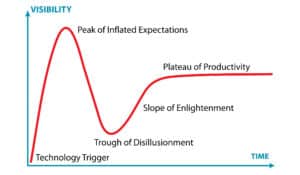Education buzzwords come and go, just as the fads they sometimes represent.
But some endure and come back, much as in the Gartner Hype Cycle—or perhaps as in a metaphorical Ferris wheel, in which concepts take their seats and then rise and fall, over and over.
For a variety of reasons, the buzz phrases also come to take on new meanings that were never intended originally, which makes it hard for educators, entrepreneurs, and researchers to communicate clearly and hone in on what exactly they are trying to do and why. This is problematic. As Clayton Christensen recently said to me, just as people have taken the phrase “disruptive innovation” to justify whatever they already wanted to do, people are using the phrase personalized learning—and a whole host of other terms—in a similar manner.

Peak of inflated expectations: personalized learning
Today’s most hyped phrase, personalized learning, is nearing Gartner’s peak of inflated expectations among the chattering class of education thought leaders and philanthropists.
What is personalized learning? That’s tougher to say. Many have attempted to define it, from the simple definition Heather Staker and I offered in Blended (“learning that is tailored to an individual student’s particular needs—in other words, it is customized or individualized to help each individual succeed”) to the definition that LEAP Innovations, a Chicago-based nonprofit, has used (“learning—anytime, anywhere—that is focused on, paced for, and led with the learner and designed around each individual learner’s needs, strengths, interests and goals”).
I’ve come to think EdSurge columnist and Charter School Growth Fund partner Alex Hernandez had it right when he wrote that we should stop trying to define “personalized learning” because it really isn’t a thing.
Instead, I increasingly think of “personalizing learning” as a verb. Educators are personalizing learning for their students, or helping their students personalize their own learning. The key question right now shouldn’t be about defining “it,” but instead objectively observing, categorizing, and measuring the different ways educators and students are personalizing learning and understand which approaches are and are not getting the results they seek.
In some ways, that is what LEAP is doing. Rather than focus on “personalized learning” as a specific thing, the framework it has developed is designed to measure the degree of personalization in the classroom along four dimensions: learner connected, learner focused, learner demonstrated, and learner led.
Taking a step back though, we can imagine environments personalizing learning along a great variety of dimensions. Time, place, path and pace are one set of examples. We can also allow students to personalize by exercising choice in how they learn something. We can also give students choice in what they learn. What we should be exploring, in other words, is not how well an environment personalizes along the dimensions of our preconceived notions of what is good, but what gets what results. And in what circumstances does that vary?
The best effort of which I’m aware to help people understand how to personalize learning comes from Digital Promise Global, which is creating a “learner positioning systems” framework to create standards that help educators make sound decisions based on dimensions that include social-emotional learning, general cognition, discipline, and student biographical background. What’s more, the framework will also help surface unanswered research questions on where we need better guidance to serve individual learners in particular circumstances—not on-average research-based findings.
As Vic Vuchic, the chief innovation officer & executive director of the Learner Positioning System for Digital Promise Global, said: “We have to ask, ‘What exactly are we personalizing and based on what research?’ There is a significant body of research on how kids vary in how they learn best. We need to build on this research and use it to support the development of new models that personalize in ways that represent the full diversity of learners.”
Slope of enlightenment: competency-based learning
Alongside personalized learning are a whole heap of concepts that some have declared are a necessary part of personalized learning. Competency-based learning is one of these.
But conflating competency-based learning with personalized learning is a mistake. The former is the idea that students must demonstrate mastery of a given concept—be that the possession, application, or creation of knowledge, a skill, or a disposition—before moving on to the next one.
Just because a student does not move on until demonstrating mastery does not mean that the approach to learning has been personalized for that student. And just because a student’s learning is personalized along some dimension does not mean that a student does not move on until demonstrating mastery.
In the field, competency-based learning also has some murkiness around what it means. CompetencyWorks offers a useful vision of what high-quality competency-based learning is, but of course not all providers that have left the traditional time-bound system offer a high-quality experience. And some educators in the field prefer to think of competency-based learning as less an escape from the time-bound system of education and more a curricular reform focused on the application of knowledge in deeper learning for higher-level competencies. But there is a phrase for that: deeper learning.
Deeper learning
The Hewlett Foundation has done the important work of defining deeper learning as “the skills and knowledge that students must possess to succeed in 21st century jobs and civic life. At its heart is a set of competencies students must master in order to develop a keen understanding of academic content and apply their knowledge to problems in the classroom and on the job.” Those six competencies are:
- Master core academic content
- Think critically and solve complex problems
- Work collaboratively
- Communicate effectively
- Learn how to learn
- Develop academic mindsets
Deeper learning is another phrase that is often conflated with personalized learning. But it’s clearly different, as a teacher can personalize learning on just one of the deeper learning competencies and a school can embrace deeper learning without embracing personalization as a way to get there.
From the trough of disillusionment toward the slope of enlightenment: blended learning
Another phrase that often gets thrown in the mix is “blended learning.” K–12 blended learning is at its simplest, the mix of online learning and brick-and-mortar schools with teachers.
The more complete definition from a student’s perspective is a formal education program in which a student learns in part online with some element of control over the time, place, path, and/or pace, in part in a supervised brick-and-mortar location away from home, and what a student does online is connected to what they do offline.
At its heart, things like online and blended learning should not be end goals. They are a means—perhaps the only means—to allow educators to personalize learning that is competency-based at scale. (Not so incidentally, personalized learning isn’t an end goal either, but also a means toward the ultimate goal of helping all students realize their fullest human potential).
An interesting thing has happened with blended learning along the Gartner hype cycle. As the education chattering class has glommed onto personalized learning as the “it” thing, among that group it has fallen into the “Trough of Disillusionment.” But there is a divide. Educators on the ground seem to talk far more about blended learning than personalized learning—likely because the former is actually a “thing” and delivery model they can implement. Among educators, blended learning is rebounding after lots of messy 1-to-1 iPad and laptop implementations along the slope of enlightenment.
Slope of enlightenment: project-based learning
Often confused with personalized, competency-based, deeper and blended learning, project-based learning is enjoying a renaissance.
Project-based learning focuses on helping students explore real-world problems and challenges in a dynamic, engaged, active way. The intent is to inspire students to obtain a deeper understanding of the subjects they are studying—and as a result, having students engage in projects is likely a critical part of deeper learning. Project-based learning can personalize for students along certain dimensions—if they have choice around what they explore and learn within the project—but a fully project-based environment can also unintentionally limit personalization for students in how they learn concepts.
Also interesting is the symbiotic relationship between project-based learning and blended learning. Many blended-learning programs pair online learning with projects to help students demonstrate that they can apply the knowledge they’ve learned online in deeper, real-world projects and connect their understanding across disciplines. And project-based learning can take place online and offline.
Returning to the cycle: social and emotional learning, whole-child education
The next “it” phrases rapidly gaining traction and hype are “social and emotional learning” and “whole-child education”—ideas that are not new but are making a comeback and moving toward the peak of inflated expectations.
Social and emotional learning is, according to CASEL, “the process through which children and adults acquire and effectively apply the knowledge, attitudes, and skills necessary to understand and manage emotions, set and achieve positive goals, feel and show empathy for others, establish and maintain positive relationships, and make responsible decisions.” Whole-child education generally refers to broadening education beyond a narrow focus on academic achievement to one that promotes a longer term view of success by ensuring each child is healthy, safe, engaged, supported and challenged in their education.
Some in the personalized learning world will try to say that you aren’t doing personalized learning unless you are focusing on these things as well. But although clearly symbiotic, they aren’t synonyms.
Moving forward, clarity is important. Confusion and conflation will only hurt educators trying to do what is best for an individual student in a particular circumstance trying to learn a particular concept—in other words, when they are trying to personalize learning for students.
This piece was originally published on EdSurge.
For more, see:



